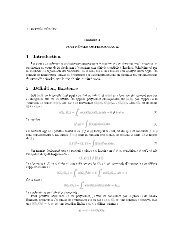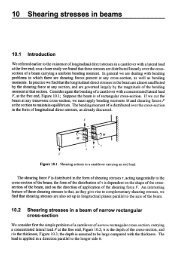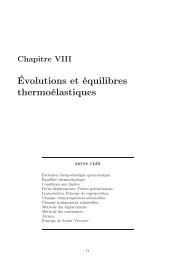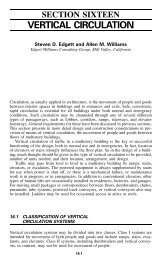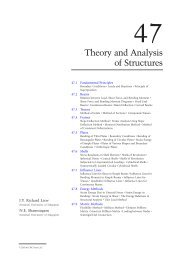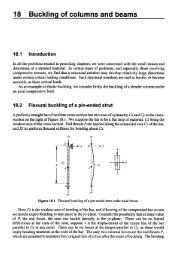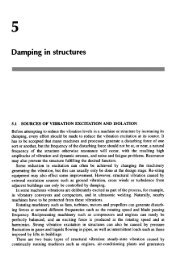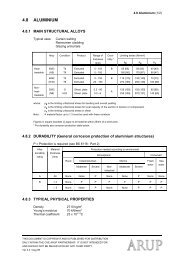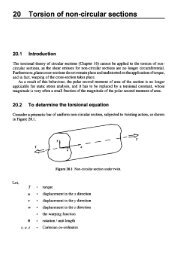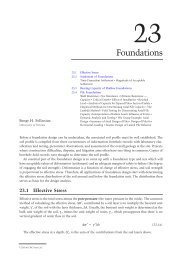Chapter 18: Groundwater and Seepage - Free
Chapter 18: Groundwater and Seepage - Free
Chapter 18: Groundwater and Seepage - Free
You also want an ePaper? Increase the reach of your titles
YUMPU automatically turns print PDFs into web optimized ePapers that Google loves.
<strong>Groundwater</strong> <strong>and</strong> <strong>Seepage</strong> <strong>18</strong>-3where p = pressure, lb/ft 2g w = unit weight of fluid, lb/ft 3–v = seepage velocity, ft/secg = gravitational constant, 32.2 ft/s 2h = total head, ftdemonstrates that the sum of the pressure head, p/g w , elevation head, z, <strong>and</strong> velocity head, – v 2 /2g at anypoint within the region of flow is a constant. To account for the loss of energy due to the viscous resistancewithin the individual pores, Bernoulli’s equation is taken as2p A v---- + z AA + ----g w 2g=2p B v---- + z BB + ---- + Dhg w 2g(<strong>18</strong>.2)where Dh represents the total head loss (energy loss per unit weight of fluid) of the fluid over the distanceDs. The ratioiDh= – lim ----- =D s Æ0Dsdh– -----ds(<strong>18</strong>.3)is called the hydraulic gradient <strong>and</strong> represents the space rate of energy dissipation per unit weight of fluid(a pure number).In most problems of interest the velocity heads (the kinetic energy) are so small they can be neglected.For example, a velocity of 1 ft/s, which is large compared to typical seepage velocities through soils,produces a velocity head of only 0.015 ft. Hence, Eq. (<strong>18</strong>.2) can be simplified top---- A+ z Ag wp---- B+ z B + Dhg w<strong>and</strong> the total head at any point in the flow domain is simply=h=p---- + zg w(<strong>18</strong>.4)Darcy’s LawPrior to <strong>18</strong>56, the formidable nature of the flow through porous media defied rational analysis. In thatyear, Henry Darcy published a simple relation based on his experiments on the flow of water in verticals<strong>and</strong> filters in “Les fontaines publiques de la ville de Dijon,” namely,v = ki = – k dh -----ds(<strong>18</strong>.5)Equation (<strong>18</strong>.5), commonly called Darcy’s law, demonstrates a linear dependency between the hydraulicgradient <strong>and</strong> the discharge velocity v. The discharge velocity, v = nv – , is the product of the porosity n <strong>and</strong>the seepage velocity, – v. The coefficient of proportionality k is called by many names depending on itsuse; among these are the coefficient of permeability, hydraulic conductivity, <strong>and</strong> permeability constant.As shown in Eq. (<strong>18</strong>.5), k has the dimensions of a velocity. It should be carefully noted that Eq. (<strong>18</strong>.5)states that flow is a consequence of differences in total head <strong>and</strong> not of pressure gradients. This isdemonstrated in Fig. <strong>18</strong>.2, where the flow is directed from A to B, even though the pressure at point Bis greater than that at point A.© 2003 by CRC Press LLC



